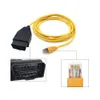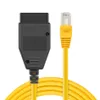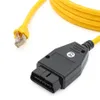The ENET cable is an essential tool for BMW F-Series vehicles that enhances data transfer speed and reliability. With faster data transfer speeds, improved diagnostics, and reduced latency, the ENET cable offers a range of benefits to users. By using the ENET cable, you can access critical vehicle data more quickly and efficiently than ever before. In this article, we’ll provide an overview of the ENET cable, its features, and how it’s designed to improve data transfer in BMW F-Series vehicles. Additionally, we’ll discuss the advantages of using the cable and offer step-by-step instructions on how to install and use it properly. Don’t miss out on the benefits of faster and more reliable data transfer – get your ENET cable today!








The ENET Cable
At its core, the ENET cable is an Ethernet cable that has been modified to fit into the OBD-II port of BMW F-Series vehicles. This means that it can be used to connect your car’s onboard computer to your laptop or other device, allowing you to access and modify various settings including engine performance, suspension calibration, and transmission settings.
One of the key features of the ENET cable is its ability to enhance data transfer speeds. With this cable installed, you’ll be able to download and upload large amounts of data much faster than with standard OBD-II cables. This means that you’ll be able to tweak your car’s performance settings more quickly and efficiently, giving you a significant advantage over other drivers on the road.
Another important feature of the ENET cable is its reliability. Unlike many other OBD-II cables, the ENET cable is built to last. It features high-quality connectors and wiring that can withstand the rigors of regular use, ensuring that you won’t experience any connection issues or data transfer errors.
Overall, the ENET cable is a must-have accessory for any BMW F-Series owner who wants to get the most out of their car’s performance capabilities. With its lightning-fast data transfer speeds, reliable connectivity, and ease of use, this cable provides an unbeatable combination of speed, reliability, and convenience that is sure to impress even the most demanding car enthusiasts.
Benefits of Using the ENET Cable
In today’s fast-paced world, the demand for reliable and efficient data transfer is higher than ever. Whether you are a professional in a corporate setting or an avid gamer, the need for faster data transfer speeds, improved diagnostics, and reduced latency is crucial. This is where the ENET cable comes into play, offering a range of advantages that cater to the needs of consumers.
First and foremost, one of the key benefits of using the ENET cable is the significantly faster data transfer speeds it provides. With the increasing size of files and the growing demand for high-definition content, traditional cables often struggle to keep up. The ENET cable, however, offers lightning-fast data transfer speeds, allowing users to transfer large files in a fraction of the time it would take with other cables.
In addition to faster data transfer speeds, the ENET cable also boasts improved diagnostics, making it easier for users to identify and troubleshoot any issues that may arise. This is particularly beneficial for professionals working in IT or network management, as it allows them to quickly pinpoint and resolve any connectivity problems, ultimately saving time and minimizing downtime.
Furthermore, the ENET cable offers reduced latency, which is essential for tasks such as online gaming or video streaming. Latency, often referred to as “lag,” can significantly impact the user experience, causing delays and interruptions. By using the ENET cable, consumers can enjoy a smoother and more seamless experience, free from the frustrations of lag.
How to Use the ENET Cable
Step 1: Gather the necessary materials
Before getting started, make sure you have all the necessary materials at hand. This includes the ENET cable itself, a laptop or computer with the appropriate software installed, and access to the vehicle’s OBD port.
Step 2: Install the software
The first step in using the ENET cable is to install the appropriate software on your computer. There are several different software options available, so make sure to choose one that is compatible with your vehicle and meets your specific needs. Once the software is installed, follow the instructions to set it up and configure it for use with the ENET cable.
Step 3: Locate the vehicle’s OBD port
Next, you will need to locate the OBD port on your vehicle. This port is typically located under the dashboard on the driver’s side, although the exact location may vary depending on the make and model of the vehicle. Consult your vehicle’s manual if you are having trouble finding the OBD port.
Step 4: Connect the ENET cable
Once you have located the OBD port, connect one end of the ENET cable to the port and the other end to your computer. Make sure the connections are secure to ensure proper communication between the vehicle and the software on your computer.
Step 5: Access the vehicle’s systems
With the ENET cable connected, you can now access the various systems within your vehicle. This may include the engine control unit (ECU), transmission, ABS, airbags, and more. Depending on the software you are using, you may be able to perform diagnostics, read error codes, and even make customizations to certain features of the vehicle.
Step 6: Follow safety precautions
It is important to exercise caution when using the ENET cable, especially when making changes to the vehicle’s systems. Always follow the manufacturer’s recommendations and avoid making any changes that could potentially compromise the safety or performance of the vehicle.
In conclusion, using an ENET cable can be a valuable tool for who want to take control of their vehicle’s diagnostics and customization. By following the steps outlined in this guide, you can confidently use the ENET cable to connect to your vehicle’s OBD port and access its various systems. Remember to always prioritize safety and follow the guidelines provided by the software and vehicle manufacturers.
FAQ
Q: What is an ENET cable and how does it benefit BMW F-Series vehicles?
A: An ENET cable is a specialized tool that allows for efficient data transfer between a computer and a BMW F-Series vehicle. It provides a durable and user-friendly solution for performing diagnostic and coding tasks on the vehicle’s various systems, including the engine, transmission, and other electronic components.
Q: How easy is it to use an ENET cable with a BMW F-Series vehicle?
A: Using an ENET cable with a BMW F-Series vehicle is extremely easy, even for those with limited technical knowledge or experience. Simply connect the cable to the OBDII port on the vehicle, then use a compatible software program to access the vehicle’s systems and perform diagnostic or coding tasks as needed.
Q: Can an ENET cable be used with other types of vehicles besides BMW F-Series models?
A: While ENET cables are specifically designed for use with BMW F-Series vehicles, they can also be used with certain other makes and models that utilize similar diagnostic protocols and systems. However, it’s important to check compatibility before attempting to use an ENET cable with a non-BMW vehicle.
Q: What are some of the key benefits of using an ENET cable for diagnostics and coding on a BMW F-Series vehicle?
A: One of the most significant benefits of using an ENET cable is its ability to enable fast and efficient data transfer between a computer and the vehicle’s various systems. This can save time and money by allowing for quicker diagnoses and repairs, as well as more accurate coding and customization of settings. Additionally, ENET cables are highly durable and designed to withstand frequent use, making them a reliable and cost-effective investment for BMW technicians and DIY enthusiasts alike.